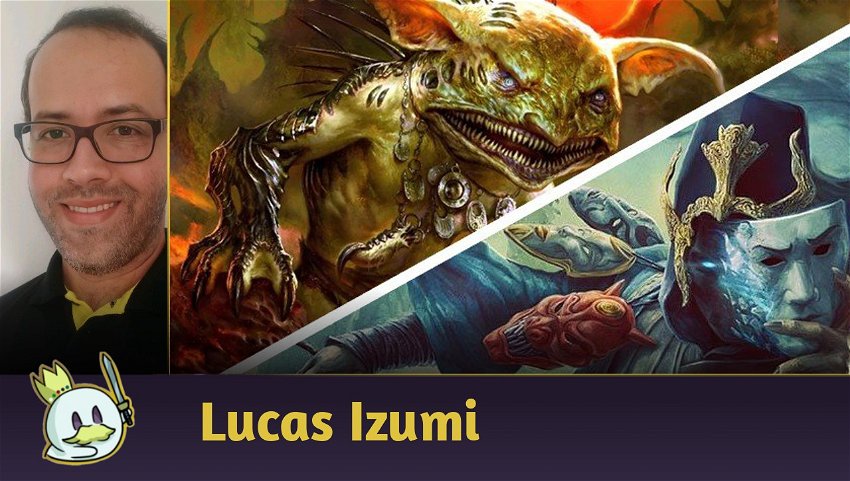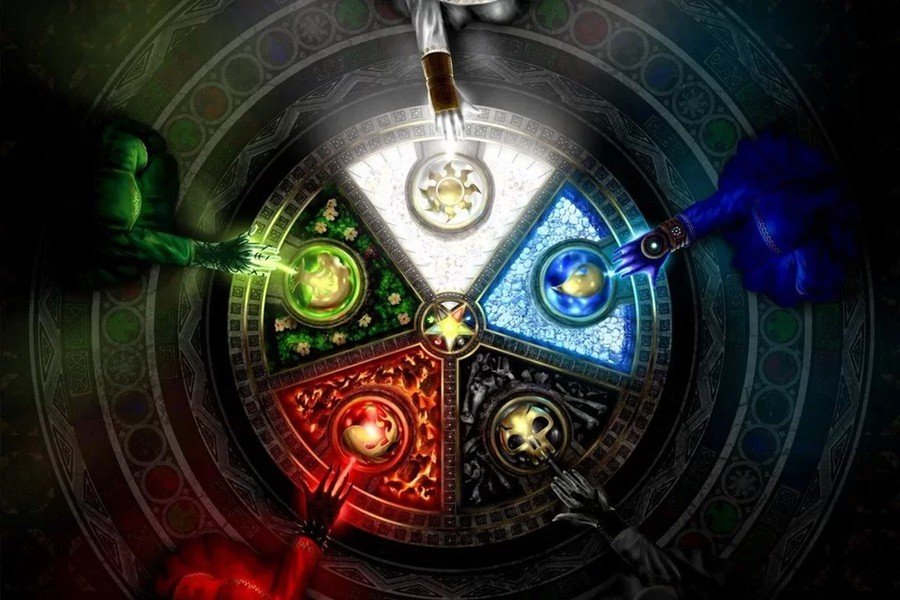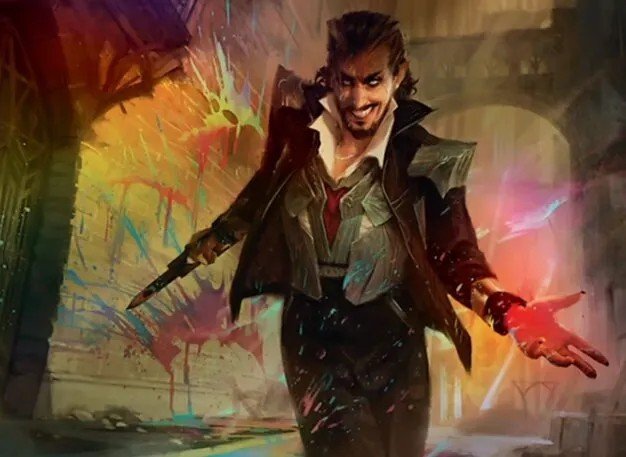About the Commanders
One day, somewhere in the world, a Magic player looked at Krark, the Thumbless and thought: how could I abuse this effect, which is almost a joke, to build one of the strongest decks in the world? Commander? That day Krark, the Thumbless found a friend: Sakashima of a Thousand Faces, and they never parted.
Krark and Sakashima are the commanders of, I dare say, the best Storm deck within the Commander format. Not only they easily increase the Storm count, but the base of the deck helps create a synergy where resources automatically replenish themselves, basically allowing you to recycle cards from your hand, deck, and graveyard until you finally end the game.
This is a deck that plays 100% around its commanders, Krark is key here and Sakashima scales his partner's powers by removing the legend rule, allowing us to clone Krark and abuse his ability multiple times.

Krark's ability initially seems to have a drawback: if you miss the coin flip, you return the spell to your hand, which seems bad because you wasted mana for nothing and couldn't play your spell.
When you win, though, you're basically doubling your spells, which is great. But you know what would be better? If you could perform both effects. This is where it comes in:

When Sakashima enters copying Krark, we have two instances of the goblin's ability.
Imagine that, on resolving one of them, you win the coin toss: your spell will be copied. Now imagine that when the other ability resolves, you lose the coin toss: the spell will be returned to your hand.
That is, you spent mana and played the spell you wanted, but it returned to your hand, and you can play it again (if you have the mana to do so). With this scenario, we can generate a cycle that allows us to play the same spell again and again and again.
Suggested List
The following list contains all the engine needed for the deck to run well, and was put together in a budget version to show that the deck doesn't need much to run.
About the Deck
An important point about playing with this deck, you will be flipping many coins as you play. Given its shape and composition, a coin that lands badly on cards can damage both cards and shields, so be careful when using coins in games with Krark.
It is good to know that, according to MTR (Magic: The Gathering Rules) item 705.3, the player is allowed to substitute a coin toss for a die (asking for “even” or “odd”, for example), or any other method that is sufficiently randomized and has equal probabilities for both outcomes (provided the opponent agrees).
Understanding the deck's engine
The deck relies on Krark, the Thumbless ability to copy and return spells to your hand, so it's essential to understand how its effect works in different scenarios.
The central idea is to increase the Storm count as much as possible and end the game with a card like Grapeshot or Brain Freeze. It's important to remember, though, that it only goes up when you cast a spell.
That is, if you play the spell once and copy it 30 times, the count remains at 1. That's why the ability to return the spell to the hand is so important. You gain the value of it being played through the copy(s) and can recast it, thus increasing the Storm count.
To allow the cycle to be possible without damaging your mana pool, cards like Desperate Ritual, Pyretic Ritual and the like are essential.
Scenario 1

Consider the following scenario: I have Krark, the Thumbless, Sakashima of a Thousand Faces copying Krark, the Thumbless and some other clone copying Sakashima (which is copying Krark). When playing an instant or sorcery spell, I will have 3 instances of Krark's ability trigger. Assume the spell played was Desperate Ritual. Let's look at some possible cases and what the result is:
- Won Krark's coin flip: a copy of Desperate Ritual has been placed on the stack, and you get priority. If everyone passes priority, the copy of Desperate Ritual resolves (the copy needs to resolve before we flip the next coin), adding 3 red mana to your mana pool.
- Missed Sakashima's coin toss: Desperate Ritual leaves the stack and returns to your hand. No one has priority at this point, so no one can prevent the card from returning to your hand.
- Won the clone's coin toss: It doesn't matter if the original spell moved zones (went to exile, deck, graveyard, or hand), the copy goes to the pile and anyway. You get priority. If everyone passes priority, the copy of Desperate Ritual resolves, adding 3 red mana to your mana pool.
Final status:
Desperate Ritual Location: Hand
Amount of mana stored 6 red mana
Storm Count: 1
Scenario 2
With Desperate Ritual in hand, you have a chance to replay it and have enough mana to do so. Let's assume you did, spending 2 red mana and having 4 mana in your pool.
- Missed Krark's coin toss: Desperate Ritual leaves the stack and returns to your hand.
- Winned Sakashima's coin flip: A copy of Desperate Ritual has been placed on the stack, and you get priority. If everyone passes priority, the copy of Desperate Ritual resolves, adding 3 red mana to your mana pool.
- Missed clone coin toss: Desperate Ritual is no longer on the stack, so there's nothing to do.
Final status:
Desperate Ritual Location: Hand
Amount of mana stored: 7 red mana
Storm Count: 2
Scenario 3
Now with 7 mana in the pool, spend 2 again to recast Desperate Ritual, leaving you with 5 mana in the pool:
- Missed Krark's coin toss: Desperate Ritual leaves the stack and returns to your hand.
- Missed Sakashima's coin toss: Desperate Ritual is no longer on the stack, so there's nothing to do.
- Missed clone coin toss: Desperate Ritual is no longer on the stack, so there's nothing to do.
Final status:
Desperate Ritual Location: Hand
Amount of mana stored: 5 red mana
Storm Count: 3
Scenario 4
Finally, one last scenario in this chain of examples: I spend 2 more mana from the pool to play Desperate Ritual again, leaving 3 mana in the pool.
- Won Krark's Coin Toss: A copy of Desperate Ritual is placed on the stack, and if it resolves, adds 3 red mana to your pool.
- Won Sakashima's coin flip: A copy of Desperate Ritual is placed on the stack, and if it resolves, adds 3 red mana to your pool
- Won clone coin flip: A copy of Desperate Ritual is placed on the stack, and if it resolves, adds 3 red mana to your pool.
- Original Desperate Ritual resolves, adding 3 mana to your pool.
Final status:
Desperate Ritual Location: Cemetery
Amount of mana stored 15 red mana
Storm Count: 4
Note that in the last scenario, the Desperate Ritual is placed in the graveyard. This is the worst-case scenario possible in this deck, as you stop the recursion. That's why the deck runs so many clones. The more instances of Krark, the Thumbless ability triggers, the greater the chance that at least one coin toss will be missed, so the spell returns to the hand, and we can continue casting it.
You might be wondering: what if my opponent counters my original spell? As stated in one of the examples above, even though the original spell has changed zones (in which case it may have gone to the graveyard or exile after the counter had resolved), the copies continue to work.
If you missed a coin flip after the spell was countered, it would stay in the zone it is in, and you wouldn't return anything to the hand (you can only return it to the hand with this ability if it's still on the stack).
Note that even if your original spell is countered, your recursion has been broken, but you will still be gaining value from your copies. That's what makes this a very difficult deck to interact with because when you play a spell, it's almost certain that it will always resolve, whether it's the original or through copies.
You also create an environment that is difficult to predict because each copy needs to resolve completely before we move on to the next trigger, the opponent doesn't know whether we will have more copies popping up or not. Not even whoever is piloting the deck knows. Do I counter the original copy? I hope some copies will solve? Maybe they all fail… This is where the odds play in our favor, creating an environment where there are no 100% optimized options for our opponents.
Mana Resources
The deck has an extensive array of resources that generate mana when you play a spell or activate abilities, even allowing spells that don't generate mana to be used as recursion.
Storm-Kiln Artist and Tavern Scoundrel reward you for abusing Krark, the Thumbless. With at least one of them in play, every time you manage to copy a spell, you'll receive treasures that can allow you to recast that same spell if the original returns to your hand. With that, a simple Opt might be all you need to start your spell recursion and raise your Storm count.
Rituals are the sources of mana that work by themselves. With Krark in play and some clones or supports, you can perform recursion using the resources that the ritual itself provides (as shown in the example in the previous section).

Card Advantage
The deck runs with several cantrips that help you find exactly what you need. The redundancy here is merely to help you draw one of them naturally and be able to copy it multiple times.

Clone Army
Although you can start risking the deck's recursion with just Krark, the Thumbless, ideally we have as many copies of it as possible, which greatly increases the chances of the deck running more optimally.
The clones that make up the deck basically serve the same purpose, but each group has its peculiarities, which it is important to pay attention to when playing.

Sakashima of a Thousand Faces and Spark Double are the main stars when it comes to clones. Both, differently, have an extra ability, which allows us to create clones of legendary creatures without having to apply the legend rule on them. That is, we managed to have two Krarks without problems. Sakashima and Spark Double should always be used to clone Krark.
The second group are the clones who can only clone their creatures.

This group allows us to select some options, depending on the direction the game is taking and our need.
If you need more mana engines, we could clone a Tavern Scoundrel. To amplify Krark's power, we could clone a Harmonic Prodigy. If the goal, however, is to clone Krark, you must always clone a Spark Double or Sakashima of a Thousand Faces that is cloning Krark. As these creatures do not remove the legend rule, if you try to clone Krark directly, you will need to sacrifice either the clone or Krark himself.
Another important point: as much as Sakashima removes the legend rule from all your permanents, never clone Krark directly just because Sakashima is on the battlefield because if Sakashima is removed, the legend rule will apply again, and you will end up losing your clone.
The third and final group are clones that can also clone your opponent's creatures

Here the same rules apply as in the second group, but feel free to clone your opponents' resources if it makes sense and is advantageous for the deck.
Increasing the Odds
We have seen that clones play an important role within the deck because they help to increase the number of coins tossed and, consequently, the odds that we will succeed in the deck's strategy.
We have key cards that have a complementary effect and that fit this deck like a glove.

Harmonic Prodigy and Veyran, Voice of Duality guarantee an additional trigger for each of our Krarks, virtually doubling the number of coins we toss. With Krark's Thumb, we improved the scenario even further and added a vital ability to the deck: being able to choose the outcome.
We know that the ideal is whenever we can copy the spells, but that the original spell returns to our hand so that we can cast it again. Using Krark's Thumb this possibility proves to be much more feasible.
Winconditions
Three of the deck's winconditions are based on cards that have storm or that interact with copying or casting spells, something that is difficult to answer and that can affect the entire table at once.
Grapeshot or Ral, Storm Conduit
These two cards share the use of the deck's engine to be able to serve as finishers.
The more spells we can copy with Krark, the more damage Ral will do. The more spells we can return to hand and recast, the higher our Storm counter will be, resulting in a flurry of copies of Grapeshot when we cast it.
Dualcaster Mage
The Dualcaster Mage + Heat Shimmer or Twinflame is one of Commander's most classic combos and couldn't be missing from this deck. A super accessible and powerful two-card combo only helps to make this deck more robust. In case you still don't know, it works like this:
1. Cast Twinflame or Heat Shimmer targeting any creature (the only thing that changes between these two spells is the target restriction. Twinflame can only be used on our creatures, and while Heat Shimmer can be used on any).
2. With the spell still on the stack, I play Dualcaster Mage in response, targeting the spell.
3. Changes the copy target to the Dualcaster Mage that just entered the battlefield. A copy of Dualcaster Mage will be generated, and its ability will go on the stack.
4. With the copy's ability, target Heat Shimmer or Twinflame. Go back to step 3.
You can do this as long as you like, to generate a considerable amount of Dualcaster Mage with haste. After that, just attack your opponents (who will hardly have enough blockers).
Brain Freeze
Brain Freeze's role in this deck is to mill your opponents decks. There is no advantageous move in this version of milling your own deck. Once the storm count is high enough, cast it from your hand. If you manage to get it back with Krark's ability, play again with another target and continue until all opponents lose.
This changes, however, in the competitive version (list available at the end of the article), which uses Brain Freeze along with Underworld Breach to mill your own deck until the storm count is enough to mill each opponent's deck. The combo works as follows:
1. Cast Underworld Breach.
2. Cast Lion's Eye Diamond (the zone doesn't matter, it can be from your hand or from the graveyard with Underworld Breach).
3. Cast Brain Freeze targeting yourself (the zone doesn't matter, it can be from your hand or from the graveyard with Underworld Breach).
4. Activate Lion's Eye Diamond, generating 3 mana and placing it into your graveyard. You now have Lion's Eye Diamond and Brain Freeze in the graveyard.
5. Go back to step 2. When the storm count is high enough, instead target each of your opponents with Brain Freeze.
Competitive Version
The following list was developed by Ken Baumann of Stacked EDH, a fan of the Krark and Sakashima duo.
Note that the base of the deck is basically the same, and the big difference is in the mana rocks and the "free spells", which immensely speed up the deck's plays, allowing you to fit a combo or risk a storm chain in turns 2 or 3.
Conclusion
And remember, this is a non-deterministic deck, meaning it can behave differently.
At the end of the day, it's all about probability, and even though we raise our odds, there's still that moment where everything can go wrong. On the bright side, right or wrong, it's a very difficult deck to interact with and a lot of fun to pilot.
Hope you enjoyed it and don't forget to share your experiences in the comments.














— commentaires 0
, Réactions 1
Soyez le premier à commenter